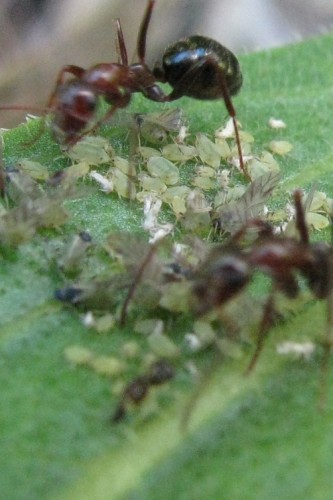Aphis echinaceae (Hemiptera: Aphididae)
Description:
We recently learned that the aphids occupying Echinacea angustifolia are a unique species, different from those on E. purpurea and other Asteraeceae (Lagos and Voegtlin 2009). We know very little about the newly-classified Aphis echinaceae. Although aspects of their morphology resemble root-feeding aphids of the genus Protaphis and the subgenus Pseudoprotaphis (Lagos and Voegtlin 2009), we find aphids on Echinacea leaves, stems, and heads. During the summer of 2010, Lauren Hobbs and Hillary Lyons, students with the Echinacea project, found that A. echinaceae do not grow on close relatives to E. angustifolia, including other Echinacea species. This indicates that A. echinaceae is a specialist to E. angustifolia.
The Echinacea project has observed and collected data on aphids over many years. We have noticed interactions between aphids and ants, as indicated by ant-built domatia (aphid cultivation structures) on aphid-infested plants. Aphid infestation tends to increase later in the summer–in late July and August–and drop rapidly when temperatures start to drop. Plants with heavy infestations early in the summer tend to have stunted, wrinkled leaves; we suspect this is due to overwintering by aphids, but that is a question that remains to be investigated.
Countless questions remain about A. echinaceae and its ecology. These include:
- Effects on host fitness
- Relationships with other species–e.g. ants, predators, parasitoids, bacterial symbionts
- Geographic range: All of the specimens from Lagos and Voegtlin’s identification came from Douglas County, MN. We do not know to what extent A. echinaceae are present throughout the range of E. angustifolia, or how populations differ throughout the range.
Team-members who have conducted research on this species: Lauren Hobbs, Hillary Lyons, Katherine Muller
Citations:
Lagos, D.M. and D.J. Voegtlin. 2009. A new species of Aphis in Minnesota (Hemiptera: Aphididae) on narrow-leaved purple coneflower, Echinacea angustifolia. The Great Lakes Entomologist 42: 91-96.
